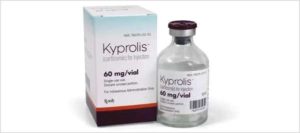
Recently Diagnosed or Relapsed? Stop Looking For a Miracle Cure, and Use Evidence-Based Therapies To Enhance Your Treatment and Prolong Your Remission
Multiple Myeloma an incurable disease, but I have spent the last 25 years in remission using a blend of conventional oncology and evidence-based nutrition, supplementation, and lifestyle therapies from peer-reviewed studies that your oncologist probably hasn't told you about.
Click the orange button to the right to learn more about what you can start doing today.
- You are here:
- Home »
- Blog »
- Multiple Myeloma »
- Multiple Myeloma Chemotherapy- Carfilzomib Cardiotoxicity
Multiple Myeloma Chemotherapy- Carfilzomib Cardiotoxicity

“…this study monitored patients for predictors of CVAEs and found a greater incidence, with 51% of (multiple myeloma treated w/ CFZ) patients experiencing CVAEs, including heart failure, hypertension, arrhythmia, acute coronary syndrome, pulmonary hypertension and venous thromboembolism.”
The good news is that multiple myeloma chemotherapy approvals by the FDA have come regularly over the past dozen or so years. The bad news is that some of those myeloma chemotherapy regimens are cardiotoxic. Carfilzomib (kyprolis) is just such a cardiotoxic myeloma chemotherapy.
For example, if your multiple myeloma (MM) has relapsed and you are undergoing more chemotherapy in hopes of achieving another remission, the last thing you, the MM survivor needs is to “experience cardiac issues.”
According to the top study linked and excerpted below, more than half of relapsed MM patients undergoing carfilzomib will experience heart damage.
If my personal multiple myeloma experience is any indicator, MM patients who have undergone cardiotoxic chemotherapy will experience heart damage in the months and years following CFZ administration.
In other words, heart damage can be a “late stage” side effect. MM patients may feel fine for awhile after cardiotoxic chemotherapy and then wham…a diagnosis of chemotherapy-induced cardiomyopathy.
The recommendation of the study is to monitor the MM survivors heart before, during and after CFZ therapy with “with natriuretic peptide testing.” And while I certainly agree with this recommendation, as a MM survivor who lives with chemotherapy-induced cardiomyopathy, I urge you to take whatever evidence-based therapies you can to reduce your risk of heart failure.
Your multiple myeloma has relapsed. Your oncologist has recommended carfilzomib (kyprolis). You want to achieve remission again yet this side effect of CFZ scares you. What do you do???
According to the other study linked and excerpted below, “curcumin significantly ameliorates (makes better) CFZ cytotoxic effect.”
Just as important, according to the study “curcumin addition enhanced CFZ proapoptotic effect.” Curcumin synergizes with carfilzomib to create a more effective MM killer.
Curcumin supplementation can reduce the cardiotoxicity of CFZ while it synergizes with Carfilzomib. You may be able to achieve a longer remission with less toxicity.
David Emerson
- MM Survivor
- MM Cancer Coach
- Director PeopleBeatingCancer
Recommended Reading:
The PeopleBeatingCancer Side Effects Program
Cardiac toxicity risk factors identified with relapsed multiple myeloma therapy
“More than half of patients with relapsed multiple myeloma treated with carfilzomib experienced cardiac issues during treatment, according to a multi-institutional study. The study recommends that patients undergo a detailed cardiovascular history before being prescribed carfilzomib and then be monitored with natriuretic peptide testing, an indicator for heart failure.
The study looked at two proteasome inhibitor therapies, carfilzomib and bortezomib. While prior studies have demonstrated a modest increase in cardiovascular adverse events (CVAEs) with carfilzomib, this study monitored patients for predictors of CVAEs and found a greater incidence, with 51% of patients experiencing CVAEs, including heart failure, hypertension, arrhythmia, acute coronary syndrome, pulmonary hypertension and venous thromboembolism.
The incidence of CVAEs with bortezomib therapy was substantially lower, accounting for 17% of patients..
Curcumin ameliorates the in vitro efficacy of carfilzomib in human multiple myeloma U266 cells targeting p53 and NF-κB pathways.
“Pharmacological therapy improves response frequency even if with various associated toxicities. Herein, we investigated if combination of curcumin with carfilzomib (CFZ) can induce a better cytotoxic effect on in vitro cultured U266 cells.
Cell viability data showed that curcumin significantly ameliorates CFZ cytotoxic effect.
Furthermore, curcumin alone did not affect proteasome at the tested dose, confirming the involvement of different mechanisms in the observed effects. U266 cells exposure to curcumin or CFZ increased reactive species (RS) levels, although their production did not appear further potentiated following drugs combination.
Interestingly, NF-κB nuclear accumulation was reduced by treatment with CFZ or curcumin, and was more deeply decreased in cells treated with CFZ-curcumin combinations, very likely due to the different mechanisms through which they target NF-κB.
Our results confirmed the induction of p53/p21 axis and G0/G1 cell cycle arrest in anticancer activities of both drugs, an effect more pronounced for the CFZ-curcumin tested combinations.
Furthermore, curcumin addition enhanced CFZ proapoptotic effect. These findings evidence that curcumin can ameliorate CFZ efficacy, and lead us to hypothesize that this effect might be useful to optimize CFZ therapy in MM patients.
Grade 3 or worse adverse events (AE), such as anemia, hypertension, dyspnea, and decreased lymphocyte count were more frequently reported by the carfilzomib group than the bortezomib group.
As always, it is important for multiple myeloma patients and survivors to thoroughly understand what can be expected from new chemotherapy regimens. First and foremost, kyprolis (carfilzomib) offers hope to relapsed and refractory (R/R) myeloma patients. Increases in overall response and progression-free survival are important.
However, it is essential to note the differences in short, long-term and late stage side effect compared with bortezomib aka adverse events. After all, studies show that patients who discontinue chemo due to side effects have worse overall survival.
I understand that if a MMer has relapsed he/she often will do anything to manage his/her MM. I too ignored the threat of side effects. That was a mistake.

Chemotherapy-induced peripheral neuropathy (CIPN) is an excellent example of a long-term side effect that will make your life miserable as it progresses. And more importantly, there are a host of complementary and integrative therapies shown to reduce or eliminate this painful side effect. Research shows that CIPN can be reduced or completely healed with
- acupunture
- low-level laser therapy
- nutritional supplements
- more
My point is that managing MM is about more than remissions- its about balancing conventional (FDA approved) therapies with evidence-based, non-conventional therapies.
I am a long-term MM survivor and MM cancer coach. . My experience is that MMers need the best of both conventional and non-conventional therapies to manage their MM and their quality of life.
Please watch the video below to learn more about the evidence-based, integrative therapies to combat treatment side effects and enhance your chemotherapy.
Recommended Reading:
- Multiple Myeloma Bone Health Therapies- both Conventional and Non-Conventional
- Can You Get Multiple Myeloma On the Job???
- Prevention of chemotherapy-induced peripheral neuropathy
Carfilzomib Improves Overall Survival in Relapsed/Refractory Multiple Myeloma
“Carfilzomib may significantly improve overall survival (OS) compared with bortezomib in patients with relapsed/refractory (R/R) multiple myeloma, according to a study published in the Lancet Oncology…
The first interim analysis of ENDEAVOR demonstrated the superiority of carfilzomib over bortezomib in multiple outcomes, such as progression-free survival, objective response, and median duration of response. At the time of the first interim analysis however, OS data was not available as the median follow-up was set to approximately 12 months…
Grade 3 or worse adverse events (AE), such as anemia, hypertension, dyspnea, and decreased lymphocyte count were more frequently reported by the carfilzomib group than the bortezomib group. There were similar rates of pneumonia, thrombocytopenia, and fatigue. The frequency of grade 2 or worse peripheral neuropathy was significantly lower in the carfilzomib group…”
Incidence and management of adverse events in patients with relapsed and/or refractory multiple myeloma receiving single-agent carfilzomib
“Carfilzomib, a selective proteasome inhibitor approved in the USA in 2012, is a single agent for relapsed and refractory multiple myeloma…
In the pivotal Phase II study (PX-171-003-A1), carfilzomib 20/27 mg/m2 provided durable responses in a heavily pretreated population with relapsed and refractory multiple myeloma (n=266), with an overall response rate of 22.9% and a median duration of response of 7.8 months.
In an integrated safety analysis of four Phase II studies, common adverse events (32.7%–55.5%) included
- fatigue,
- anemia,
- nausea,
- thrombocytopenia,
- dyspnea, and
- diarrhea.
Grade 3/4 adverse events were generally hematologic and included
- thrombocytopenia (23.4%),
- anemia (22.4%), and
- lymphopenia (18.1%).
Serious adverse events included
- pneumonia (9.9%),
- acute renal failure (4.2%),
- pyrexia (3.4%), and
- congestive heart failure (3.4%).
New or worsening peripheral neuropathy was infrequent (13.9% overall, 1.3% grade 3, no grade 4)…”



